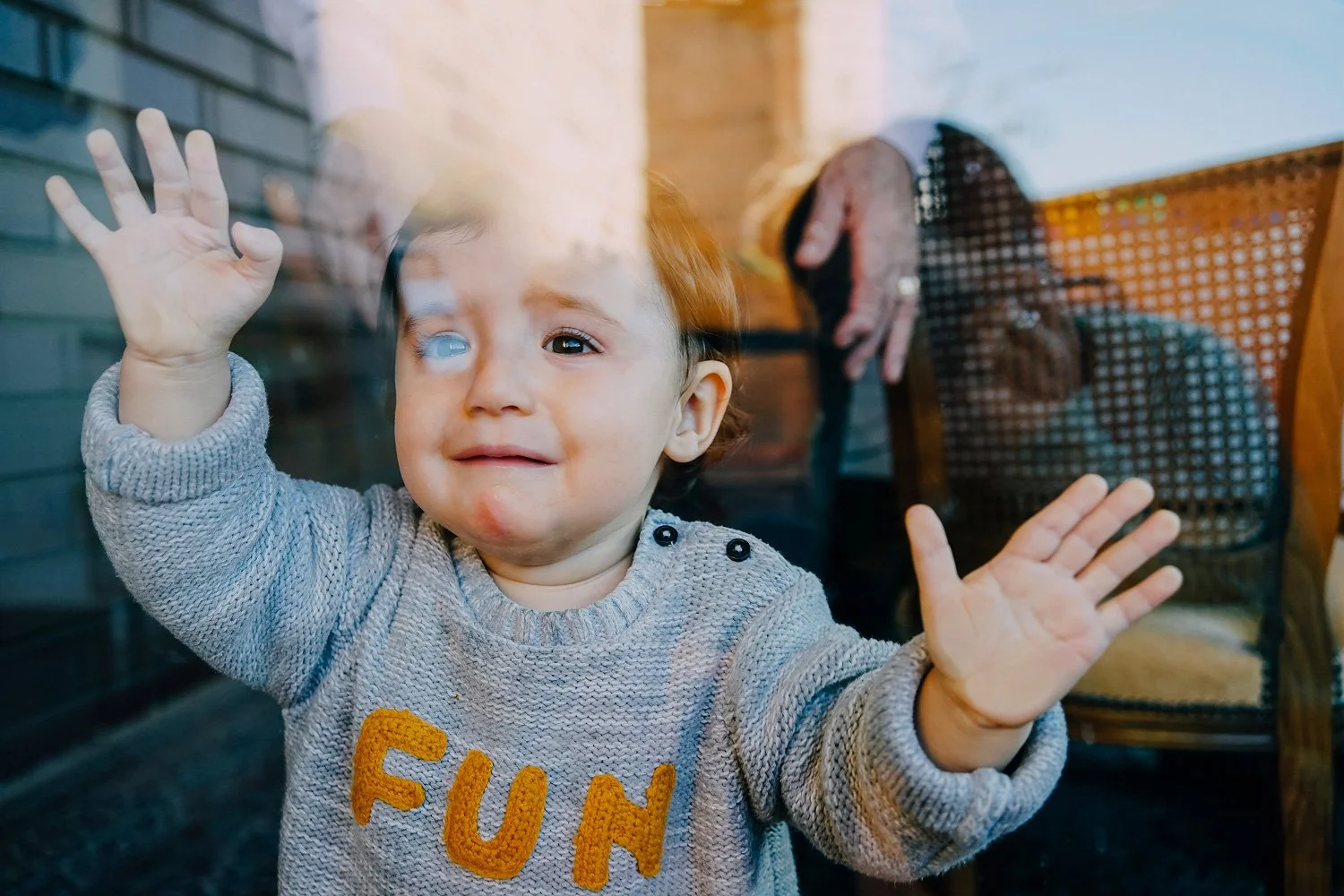10 ways to soothe separation anxiety in babies

Clinically reviewed by Dr. Chris Mosunic, PhD, RD, MBA
Separation anxiety in babies is normal but tough. Learn why it happens, the common signs, and 10 tips to help your infant feel calmer during their time apart.
It’s 9am on a Saturday, and you and your partner are playing with your baby. You give them kisses and head upstairs to take a hot shower, only to hear your baby burst into tears the second you disappear from sight. What gives?
Before, you could leave without a fuss, but now, every goodbye is a crisis.
This is separation anxiety at work. Essentially, your baby is learning that people exist even when they’re not in the room, which also means they realize when you’re gone. And while it’s a sign of healthy development, it can also cause you to feel guilt or panic.
Luckily, there are ways to make this period more manageable for everyone. Here’s what you need to know to make your goodbyes a little easier.
Why do babies get separation anxiety?
Separation anxiety is rooted in brain development. When babies are around 6 months old, they begin to understand object permanence: the idea that people and things still exist even when they can’t see them. This new awareness is exciting, but it can also mean your baby knows you’re somewhere else when you walk away.
Because you’re their safe space, your absence can feel overwhelming, and crying and clinging are your baby’s way of signaling distress. The good news? This means that your baby has formed a healthy attachment to you and they’re learning to navigate being apart.
When does separation anxiety start in babies?
Separation anxiety usually starts to show up between 6 and 8 months. At this stage, babies become more aware of their surroundings and more attached to familiar people.
Parents often notice changes in everyday interactions. A baby who once happily went to anyone has become clingy, or a child who played quietly might get upset when a parent steps away.
But every baby experiences separation anxiety differently. Some display only mild fussiness, while others have meltdowns. Still, it can be distressing either way.
How long does separation anxiety last in babies?
Separation anxiety usually peaks between 8 and 18 months. In fact, many parents notice the most intensity around their first birthday, as babies seek independence but don’t yet have the tools to handle it.
Most children gradually adapt as they reach 18 to 24 months. This is when language, memory, and coping skills help them feel more secure. Still, this doesn't mean that separation anxiety disappears. They’re just a little better at handling it.
Many times, separation anxiety can flare up during big transitions, like starting daycare or adjusting to a sibling. But it’s important to note that separation anxiety is temporary, and your baby will outgrow it as they slowly build confidence in being apart.
6 signs your infant is struggling with separation anxiety
Seeing your baby express signs of separation anxiety can be draining, but most of the time, it’s not cause for alarm.
With that said, knowing the signs can help you understand what’s typical and when your baby may need a little extra comfort. Here are six common ways separation anxiety may present in your baby:
1. Tears at goodbye: Your baby cries the moment you leave, even if they were happily playing seconds earlier.
2. Difficulty with hand-offs: Drop-offs at daycare or visits with grandparents trigger strong protests.
3. Sleep disruptions: Bedtime and naps become harder, as your baby notices your absence more keenly when they’re falling asleep.
4. Repeated check-ins: During play, your baby repeatedly looks around the room to make sure you’re still there.
5. Resistance to new people: Familiar caregivers don’t feel “safe enough” to them without you present, so they cry and refuse to be held by anyone but you.
6. Struggles with independent play: Your baby insists on staying close to you or being held instead of exploring toys on their own.
How to ease separation anxiety in babies: 10 tips to help your baby cope
Separation anxiety can feel overwhelming, but there are simple ways to help your baby build trust and confidence. While you won’t be able to eliminate separation anxiety entirely, you can give them tools to make separations more manageable.
1. Practice short separations
Mini goodbyes help train your baby for bigger and longer separations.
Try stepping into another room for a few minutes, then return with a smile and a warm greeting. Over time, your baby will begin to understand that you always come back.
Related read: Yes, separation anxiety happens to moms too. These 7 tips can help
2. Create a goodbye ritual
Consistency and predictable routines help babies feel safe.
Create a short ritual where you hug and kiss them right before you leave the room. You’ll signal to them that you’re leaving, but also that you’ll return.
💙 Baby Shhh is a calming soundscape that can help your baby relax when you’re not there.
3. Keep transitions calm and confident
Your baby takes cues from your body language, so remain calm and confident as you leave, even if your baby cries. This can reassure them that being apart is okay.
Related read: 10 (actually useful) pieces of advice for new moms
4. Offer comfort objects
A soft toy, blanket, or pacifier can provide comfort when you’re gone. Gently offer a soft toy or blanket during snuggly moments to help them associate it with safety and warmth.
5. Build trust through play
Games like peekaboo help babies practice the idea that people return after being gone.
This is a playful, low-stress way to reinforce object permanence. It also gives them a chance to laugh through what can otherwise feel scary.
6. Use familiar caregivers
Whenever possible, leave your baby with someone they already know and trust. A smooth transition is more likely when your baby feels secure with their caregiver.
If you need to use a new caregiver, try to spend a little time all together before you leave. This can help your baby feel more comfortable.
7. Time separations wisely
Leaving during a nap transition or when they’re hungry can make the separation harder to manage.
Try to schedule your goodbyes for when your baby is fed, rested, and comfortable.
8. Normalize short periods apart
Encourage brief independent play, even when you’re at home. Even small stretches can help them practice being content without constant physical closeness.
Try placing your baby in a safe spot with toys while you do something like fold laundry nearby.
Related read: 14 self-care tips to help busy moms feel like themselves again
9. Stay calm during reunions
It’s natural to rush in with excitement when you return, but a steady and warm greeting may be less overwhelming.
Calmly enter the room with a smile and hug them. Then say something cheerful like, “I missed you!”
10. Take care of yourself, too
Separation anxiety can affect parents, too. If you’re feeling guilty or stressed, remember that needing breaks is healthy.
To help you during this time, connect with other parents and lean on your support network. Also, give yourself permission to rest. This will help you show up with more patience and calm for your baby.
💙 Learn how to let go of the stress and guilt during the For Moms, With Love series with Jennifer Wallace.
Separation anxiety in babies FAQs
Why is my baby so clingy when I leave?
Your baby’s clinginess is a natural expression of separation anxiety, which shows up when babies start to understand that you still exist when you’re not in sight. Because you’re their primary source of safety, they reach for you when they feel uncertain. If you’re not there, panic can ensue.
Clinginess is just your baby’s way of staying close to what feels safe. But over time, with gentle support, they’ll learn they can handle small separations.
Can I manage my baby’s separation fear?
Consistent routines, gradual practice separations, and calm, confident goodbyes can give your baby a sense of predictability and ease their fears.
Think of it as guiding them through the process rather than trying to “fix” it. The goal is to help them slowly trust that goodbyes are temporary.
Are there transitions to ease my baby's separation anxiety?
Two transitions that can help soften your baby’s separation anxiety are spending a few minutes with your baby and their caregiver before you leave, and using a consistent goodbye ritual to signal what’s happening.
Over time, small steps like this can give your baby the security of predictability, which can make bigger separations, like starting daycare, much smoother.
Is separation anxiety in babies a normal developmental stage?
Most babies experience separation anxiety at some point, usually beginning around 6 to 8 months. This is generally tied to healthy brain development, especially the growth of memory and attachment.
And while this may feel exhausting at times, it’s just proof that your baby knows you’re their safe space.
What are tips to soothe infant separation anxiety?
The most effective strategies to soothe infant separation anxiety are easy to integrate into everyday routines. Here are four you can try:
Practice short, low-stakes separations to help your baby build confidence.
Create a consistent goodbye ritual so that your baby knows what to expect.
Leave when your baby is rested and fed to reduce stress triggers.
Offer comfort objects like a favorite blanket or toy for reassurance.
But most importantly, stay calm and steady during goodbyes. This way, your baby will learn from you that separations are safe and that reunions are reliable.
Calm your mind. Change your life.
Mental health is hard. Getting support doesn't have to be. The Calm app puts the tools to feel better in your back pocket, with personalized content to manage stress and anxiety, get better sleep, and feel more present in your life.







